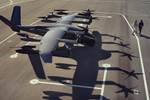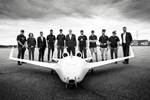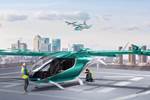Midnight eVTOL aircraft completes Phase 1 flight testing
Advancing through a third of the program in just three months, Archer continues to make rapid progress toward planned full wing-borne transition flight in Phase 2.
Midnight during Phase 1 flight testing. Source: Archer Aviation
’s (Santa Clara, Calif., U.S.) Midnight electric vertical takeoff and landing (eVTOL) aircraft has completed Phase 1 of its flight test program. Incorporating learnings from the previous 4 years of flight testing, Midnight finished the flight test phase in approximately 3 months, which is significantly faster than Archer’s full-scale prototype aircraft, Maker. Additionally, Midnight’s battery system has recently been upgraded to include some of the first high-voltage battery packs off of Archer’s manufacturing line at its San Jose facilities, a significant step as the company pushes towards becoming production-ready. With these advancements, Midnight remains firmly on track to complete its first full wing-borne transition flight and begin piloted “for credit” testing with the Federal Aviation Administration (FAA) later this year.
“Midnight is progressing efficiently through our flight test program,” Archer’s founder and CEO Adam Goldstein reiterates. “Over the last years of flight testing, our team has been able to gather a tremendous amount of data and learnings that enable us to advance Midnight rapidly towards certification. Our team’s focus on safety and relentless execution has gotten us to where we are today.”
Phase 1 of Midnight’s flight test program covered an array of progressively more complex flight maneuvers and data gathering missions. Its flight envelope will now expand further as it moves into Phase 2, which involves an incremental approach to speed testing. This means that the aircraft will continue to fly at greater and greater speeds until it achieves full wing-borne transition.
Transition is an important milestone for any VTOL aircraft, as it demonstrates in a single flight the capability to both takeoff and land vertically and cruise efficiently in wingborne flight. Once that’s completed, the aircraft will move to Phase 3, which entails flying simulated commercial routes to demonstrate the aircraft’s operational readiness.
Also read, “Archer, NASA sign agreement for eVTOL, space battery cells R&D.”
Related Content
-
PAL-V, NLR complete composite rotors for Liberty flying car
Rotor blade design spans nearly 11 meters in length for flight, with a mid-hinge to fold and accommodate 4-meter vehicle length while driving.
-
Airbus puts a pause on CityAirbus NextGen eVTOL program
Airbus Helicopters is hitting the breaks on program progress, citing that battery technologies need to evolve before it can launch a successful UAM program.
-
Joby demonstrator makes 523-mile hydrogen-electric flight
Hydrogen-electric program builds on technology developed by H2FLY subsidiary, demonstrates potential for emissions-free regional travel using Joby’s all-composite eVTOL aircraft.






